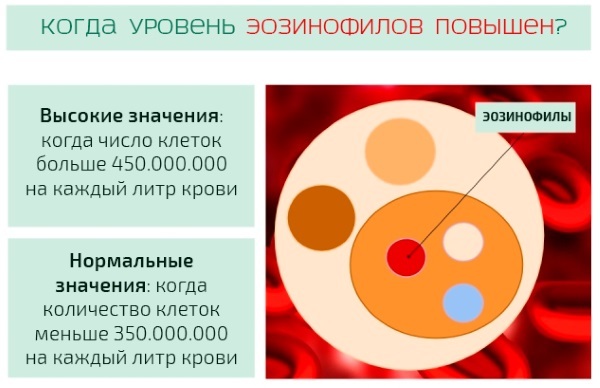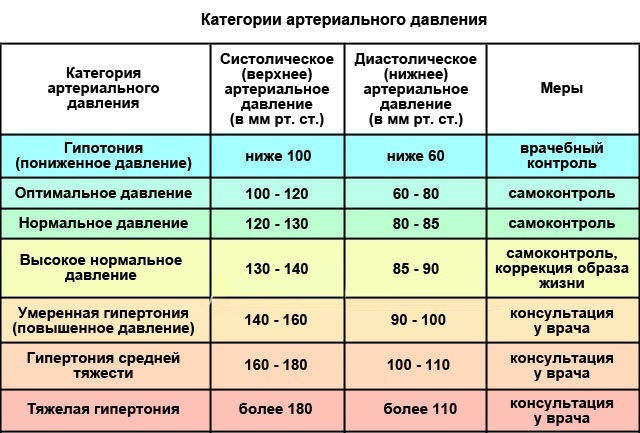We absolutely healthy people the number of eosinophils in the blood is usually slightly. Accumulated years of medical practice data show that there are specific diseases in which possible increase of eosinophils in the adult as in the peripheral blood and in various other tissues.
Eosinophil Wharton Jones was first marked in 1846, but only in 1879 he received a description of a single cell element (EO). Scientist Paul Ehrlich first used as a definition of eosin acidic dye, named after the Greek goddess Eos (the goddess of the morning Stozhatry). Eosin used during the execution of histological staining of tissues and blood cells.
The content of the article:
- 1 What is eosinophils?
- 2 eosinophil function in the body
- 3 Norms of maintenance of the adult blood
- 4 Eosinophils and lymphocytes
- 5 Symptoms of elevated blood eosinophils in adult
- 6 Non-pathological reasons for the increase
- 7 The presence of pathological causes
- 8 the degree of eosinophilia
- 9 Particularly pulmonary eosinophilia in adults
- 10 Eosinophilia during pregnancy
- 11 Diagnostics
- 12 Treatment of eosinophilia in adults
- 13 Video of elevated eosinophils in adults, the main symptoms and causes
What is eosinophils?
Large white blood cell elements are components belonging to the subspecies leukocytes "granular" called eosinophils. Normal blood white cell count is considered to be between 4 and 9 million in a cubic millimeter, and eosinophils among them are from 1 to 5 percent. The main function of eosinophils - a regulation and protection against infections.
Are the following challenges faced by this subtype of white blood cells:
- protecting the human body from bacterial and viral infections;
- participation in antiparasitic immunity and allergic reactions;
- regulation unchanging state of the organism, its internal environment (tolerance).

Eosinophils are considered to be non-dividing granulocytes - white blood cells is, is a continuous image of the bone marrow product. The formation of eosinophils - 72-96 hours. These large immune cells produced by the bone marrow, and then he left, aiming into the bloodstream, and a few hours (up to 12 hours) circulate in the blood.
These blood cells are called to be responsible for the fight against a foreign protein in people's bodies.
Once in the body fall allergens and parasitic antigens, eosinophils, they are neutralized. Decrease in white blood cells is a sign of a weak immune system and exhaustion of the internal organs of the struggle with the disease.
We have a lot of eosinophil receptors:
- immunoglobulin (IgG, IgE);
- to complement;
- to biologically active substances (histamine).
These large calf blood are capable of chemotaxis and phagocytosis. Eosinophil can act against fat cells (a type of white blood cells, also known as mastocyte or mastotsit) reducing histamine levels emitted by it.
eosinophil function in the body
Increase of eosinophils in adults is associated with two major tasks of the body immunity of people:
-
Destruction of foreign mikrochastichek, toxic elements, viruses. The main purpose of granular white blood cells is to penetrate the focal inflammation, then there initiate cell receptors that are responsible for activation of the immune system directed against parasites body. Consumed eosinophils foreign substances, particularly those viral nature or helminth infestations. Bacterial particles and various harmful components "marked" by the immune system like other alien parts for subsequent removal. Approximately parasites self-destructs cell composition is then formed membrane capsule. The number of eosinophils accumulated chemicals called mediators: phospholipase, endogenous histamine involved in important reactions.

- Regulate the inflammatory process. Under the action of inflammatory mediators eosinophil appears region, designed to isolate and control the foreign microorganism or harmful particles. But it happens that sometimes the focus of inflammation grows wider than required, resulting in damaged tissues, the appearance of painful acute symptoms. Basically, the forming elements play a major role in controlling the process of allergic manifestations, symptoms of asthma, hay fever. They delay the development of allergies and rheumatoid factors, and do not allow the total development of the disease.
Norms of maintenance of the adult blood
The normal number of white cells of adult blood components ranges from one to five percent of the total number of leukocytes. Increase of eosinophils in adults called eosinophilia. It is small (10%), moderate (20%), high (over 20%).
In the mature population norm is the value of 500 EPZs / l. in blood. Exceeding the level to the level of 5000 EPZs / l for several months, it means the development of a patient hypereosinophilic syndrome.
Eosinophils and lymphocytes
Due to the common blood test can determine the presence of these formed elements: hemoglobin, erythrocytes, reticulocytes, thrombocytes, leukocytes. In addition, there is a division into subspecies of white blood cells with specific functions: basophils, lymphocytes, monocytes, eosinophils.

White blood cells are composed of lymphocytes LYMP, responsible for the formation of a common local immunity, the rate of which is 18 to 40%. When the viral infection greatly increases the number of lymphocytes. For their expense occurs creation of humoral and cell-mediated immunity, produces antibodies in response to pathogens.
When the virus gets into the body, the body simultaneously with the number of eosinophils number of lymphocytes increases immediately. This occurs in individuals exposed to chronic allergies in people with a parasitic infestation at allergodermatosis, sarkotsidoze.
High level observed during the course of antibiotics or sulfonamides. These figures are in children during scarlet fever, under the influence of the Epstein-Barr virus. It is therefore necessary to study blood immunoglobulin E antibodies to Epstein-Barr virus and worm infestations.
Symptoms of elevated blood eosinophils in adult
Raising the threshold of eosinophils in adult patients is reflected in the following symptoms of eosinophilia:
- primary - are the main symptoms of serious illnesses hematopoietic system;
- Secondary, or reactive, which occur due to disease, it is not associated with blood disorders;
- of unknown origin.

As a rule, the excess blood content standards eosinophils manifested by symptoms:
- fatigue;
- drowsiness;
- apathy;
- pallor;
- severe headaches.
Non-pathological reasons for the increase
Eosinophils are elevated in adults for the following reasons nonpathological:
- blood disease (In particular sickle-cell anemia - invalid form erythrocytes provokes an increase in their rate of settling, and will differ significantly from the indices of the norm);
- presence of heart attack or stroke (Cases of inflammation such as acute phase proteins adsorbed into the surface of blood cells, and reduce their electrical charge);
- diseases that are associated with disturbed metabolism (In diabetes, cystic fibrosis, obesity);
- bronchial asthma;
- liver disease and problems with bile ways.
The presence of pathological causes
Eosinophils are elevated in adults in the following pathological conditions:
- parasites, worm infestations, giardiasis;
- various kinds of allergies;
- viral infection;
- blood disease
- disruption of the internal organs of the machine;
- dermatitis;
- autoimmune condition;
- Oncology.
the degree of eosinophilia
In general, the clinical analysis of blood reflects the percentage of blood leukocytes, as well as the quantitative level of eosinophils. A significant excess of fluid in the red blood vessels called eosinophilia.

Hematologists believe that eosinophilia is of three stages:
- light - from 400 to 1500h10 l ^ 9, when the peripheral blood of no more than 15% of the white blood cells;.
- moderately severe, moderate - from 1500 to 5000h10 ^ 9 liters in case of excess of 15 to 20%.
- heavy, called high blood eosinophilia - more than 9 5000h10 ^ l, where the number exceeds 20%, a condition usually associated with an increase in the total number of leukocytes..
The upper limit of the content of EO eosinophils indicators allows to evaluate the level of immunity and to determine more precisely the root of the disease. The sharp rise is observed during infection with bacterial infections, acute purulent inflammation, in the case of an existing allergic reaction during the parasitic infestation.
In the opposite cases, the fall in blood leukocyte indicates the presence of viral infections in the body. The percentage of various types of white blood cells is reflected in special leukocytic formula.
Particularly pulmonary eosinophilia in adults
Pulmonary eosinophilia differently called eosinophilic lung disease. It describes the different states, which are characterized on the radiograph or computer tomogram opacities in the lungs. This is related to eosinophil lung tissue and peripheral blood.
The diagnosis is established by at least one of the following symptoms:
- infiltration in the lung tissue, and eosinophilia is observed in the peripheral blood;
- confirmation with an open biopsy, or lung tissue eosinophilia bronhobiopsii;
- bronchoalveolar lavage fluid contains increased numbers of eosinophils.

A plurality of different categories of drugs (inhibitors of leukotrienes, CC, the fourth type of phosphodiesterase, chemokine receptors, cromolyn, cyclosporins antihistamines, monoclonal antibodies against IL5 (mepolizumab) and IL13 (lebrikizumab), interferon alpha) inhibit the activity of eosinophils or their detrimental effect products.
Eosinophilia during pregnancy
During gestation allergy can cause eosinophilia.
In patients following symptoms may occur:
- red spots on the skin, urticaria;
- stuffy nose;
- presence of light itching sensation;
- peel skin.
Excessive blood flow into the foreign protein in the body triggers a defense reactions as eosinophilia. With the development of hypoxia may develop the same condition, in the case of a lack of magnesium in pregnant women.
Characteristically similar disease and received a radiation dose of expectant mothers, or those who have different forms of congenital heart disease, or ill with scarlet fever recently. From this isolated and mixed group that consists of a variety of other diseases causing persistent eosinophilia.
Steatosis pregnant, it is a violation of the cellular substances in the liver during pregnancy also can cause eosinophilia. The disease is not cured in a timely manner, it may even bring to the terrible death of the fetus and the pregnancy itself. The main purpose of eosinophilia cure is to eliminate the pathogen directly.
Offering medical specialization course, which includes the following:
- anesthetics;
- medicines to eliminate edema;
- drugs that eliminate allergic reactions.

There are special cases where pregnancy should opt out of the purpose of medical devices.
Diagnostics
Practically, in order to refute or, on the contrary, to confirm the presence of disease, ill people need to take a blood test. Only the results will accurately represent whether elevated levels of eosinophils. As stated therein the content of white corpuscles in percentage and takes place recognition of such signs of anemia, the smaller the number of erythrocytes, the sharp decrease in hemoglobin.
At the stage of the diagnostic process the doctor carefully examines the patient's complaints, analyzes the history of the course of his illness. Preliminary diagnosis of the disease is established, based on the results of blood tests, the results of the general survey. It is often required to conduct some special studies.
Usually necessary to carry out the following additional tests:
- general urine analysis;
- for identifying the parasite - taking the analysis of stool;
- by operation of the kidneys and liver;
- X-rays of the upper thorax;
- puncture of the affected joint;
- bronchoscopy.
Treatment of eosinophilia in adults
In order to determine disease provoked eosinophilia further together with fence clinical analysis of blood and the patient is on biochemistry analysis. Untreated usually haematologist. This disease is not considered a separate disease, but rather is an expression of a symptom of another disease, in this regard, it is necessary to treat the original cause.
First you have to determine for what reason has increased the number of white blood cells, and then to carry out remedial measures, including the appointment of medical drugs with physiotherapy. The choice of different treatments carried out, focusing on the actual physical condition of the patient, the nature of his illness, his age, state of health and other co-morbidities.
It happens that in order to cure the contrary should stop taking the medication.
Careful attention should be paid to the enzymes that are located in the liver. To fully exclude the option helminthic infestation, be sure to give up antiparasitic tests. And to confirm runny nose due to allergies, take a nasal swab. Your doctor may prescribe as X-rays of the human respiratory air, taking a puncture of his aching joints.

If there is a suspicion of rheumatoid arthritis, you will need to do a bronchoscopy. Often the doctor carries out the appointment of a specialized treatment program that includes: painkillers, medicines to reduce swelling, agents that eliminate pronounced allergic reaction.
The main direction of healing lies in the elimination of the causative agent - the source of the disease. The course duration may be different, depending on the results it will be regularly adjusted, or even completely changed.
Along with drug therapy is often used in the treatment of physiotherapy treatments and herbal medicine. In addition, a doctor specialized diet can be assigned.
It is necessary to carry out periodic monitoring of blood tests in the clinic to prevent raising the level of eosinophils in adults. Always such an increase means that there is a serious illness. When there are other additional features, it is necessary to consult a doctor is necessary. eosinophilia not overcome the process itself can only be cured disease, it provoked.
Video of elevated eosinophils in adults, the main symptoms and causes
Specialist about a blood test for eosinophils:
A simple description of eosinophils:



